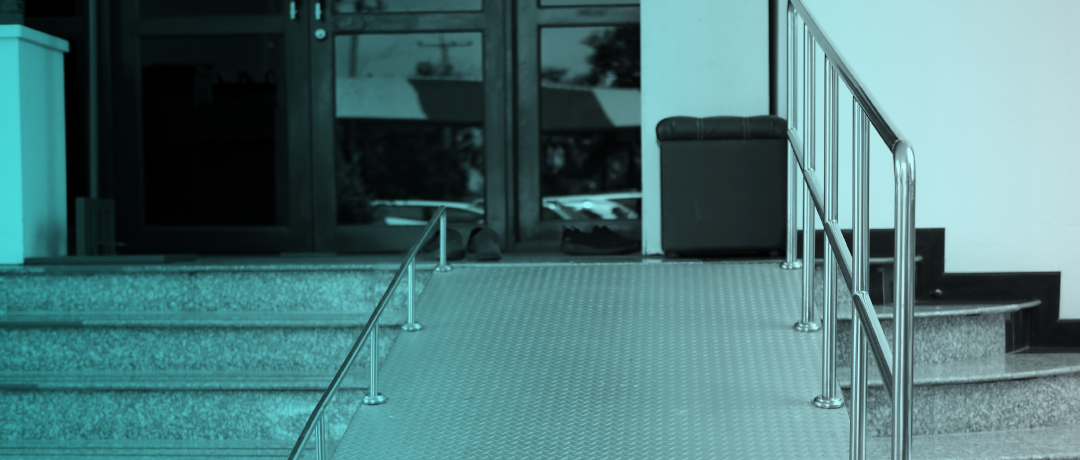Blog | How to Make Your Church More Accessible for Disabilities

How to Make Your Church More Accessible for Disabilities
Did you know that 1 in 4 American adults have some sort of disability? That means that it’s more than likely that someone you know, someone you work with, or someone you attend church with is living with a disability.
Becoming a more accessible church is about more than just your building. It’s about cultivating a community of belonging that sees, esteems, and includes all people. In Genesis 1:26-27 it says, “God created man in His own image, in the image of God He created him; male and female He created them.” Our disabled friends, family, and neighbors are not excluded from this— they too are God’s image-bearers. In them, God has placed his spirit, his calling, and inherent worth that cannot be compromised by their possession — or lack thereof— of any abilities.
However, it’s second nature in our culture for us to, at the very least, be ignorant of, and worse still, be prejudiced against our disabled friends and their needs. Like our society, our churches often aren’t designed with accessibility in mind. All of us deserve the right to worship, participate, and flourish together in a community that recognizes our worth and cares for our needs. If we’re serious about living like Jesus and bringing the kingdom of heaven here to earth, we need to get serious about making our communities accessible.
Whether your church is actively working on new ways to be accessible to disabled members or you haven’t thought much about it, there are plenty of simple, actionable things you can do to jumpstart your process.
Adapt Your Spaces and Resources
The first thing is the simplest thing: update our spaces to be physically accessible to members with functional disabilities.
For those in wheelchairs:
Bring in a wheelchair and test out the user experience.
• Are doors wide enough for you to pass through easily?
• Can you open doors from the wheelchair?
• Are there steps or curbs with no other way around?
• Is there enough space between chairs or pews to find a seat and, if so, are the only accessible spaces in the very front or very back?
If there are parts of your building that aren’t wheelchair accessible, think through practical solutions. You can prop open doors or post a greeter there to open them on Sunday mornings, install ramps, and space out chairs in your sanctuary so that wheelchair users can sit and worship anywhere they choose. This exercise is practical but it also might give you empathetic insight into how different and unconsidered maneuvering in the world can be for those in wheelchairs.
Invisible Disabilities
On a whole, our cultural awareness of problems regarding hearing loss, vision, speech, and neurological functioning is much less than that we have for those with disabilities we can see. This of course does not make these disabilities less real, valid, or worthy of our inclusion. There are multiple ways you can make church more accessible for members with “invisible” disabilities in your worship.
For Those with Hearing Loss
Hiring an ASL interpreter for Sunday morning services or providing sufficient captioning can go a long way— after all, would you want to sit through a shared experience that you couldn’t understand because you couldn’t hear it? For members with hearing aids, hearing loops are a great way to help cut out background noise and make the service more accessible. Churches can apply for grants to fund this technology HERE.
For Those with Vision Impairment
Consider providing oft-used resources— bulletins, sermon notes, Bibles, hymnals, etc.— in large print or low-vision variations. Put up thorough and easy-to-read signage and train your ushers to be able to identify and, when appropriate, help those with impaired vision to proper resources and their seats.
For Those with Sensory Sensitivities
Some members might be easily overwhelmed by loud noises and intense sensory experiences— this could include those with autism, concussions, PTSD, or even the elderly or mothers with newborn babies. Consider providing noise canceling headphones in a variety of sizes and having them available for whomever might need them.
While many churches have separate rooms for those who’d like a quieter space to stream the service, this is only a half-solution. These members might receive access to your Sunday morning content, but ultimately they are separated from the community and experience of togetherness happening in your worship center.
A simple solution that requires zero upfront investment is committing to an acoustic or low-noise worship set every month. This provides those who cannot stand overwhelming noise with consistent opportunities to sit, worship, and with their church community.
Community for Everyone
While upgrading your spaces and resources to be welcoming for those with disabilities is very important, cultivating a truly accessible church goes beyond these measures. Afterall, church is not just a building and it’s not just Sunday mornings. It’s a community.
Ask yourself how your church is currently doing to invite, include, and nurture your members with disabilities. Is it easy for them to find mentorship, get plugged into your small group ministry, volunteer, or lead? If these are things you encourage your able-bodied and able-minded members to prioritize as part of their spiritual growth, these opportunities need to be accessible disabled members, too. It’s not just a matter of inclusion; everyone has God-given gifts and we are unwittingly censoring the image of God when not everyone can bring their full selves to the table.
Matthew 19:14 says, “Jesus said, “Let the little children come to me, and do not hinder them, for the kingdom of heaven belongs to such as these.” Ask yourselves which groups of being are being kept from reaching Jesus in your congregation and how you can eliminate the obstacles. A great place to start would be asking. Rather than assuming what the disabled people in your congregation want or need, put together a committee and invite them to be a part of shaping how your church approaches making ministries, services, and volunteering teams more accessible.
Every church has their blind spots. That’s normal. But once we identify them, we’re responsible for doing something about it. Pray over Matthew 19:14 passage, ask the Holy Spirit to reveal to you how you can make your church community more inclusive for the disabled children of God in your pastoral care. Jesus sees them. We’re called to see them too.

About the Author
Emma Tarp is a writer and worship leader based in Minneapolis, MN. On her best days, she's highlighter-deep in a good book or teaching herself to sew. On her other best days, she's helping passionate folks and inspired businesses put words to their work. Find out more at emmatarp.com.
